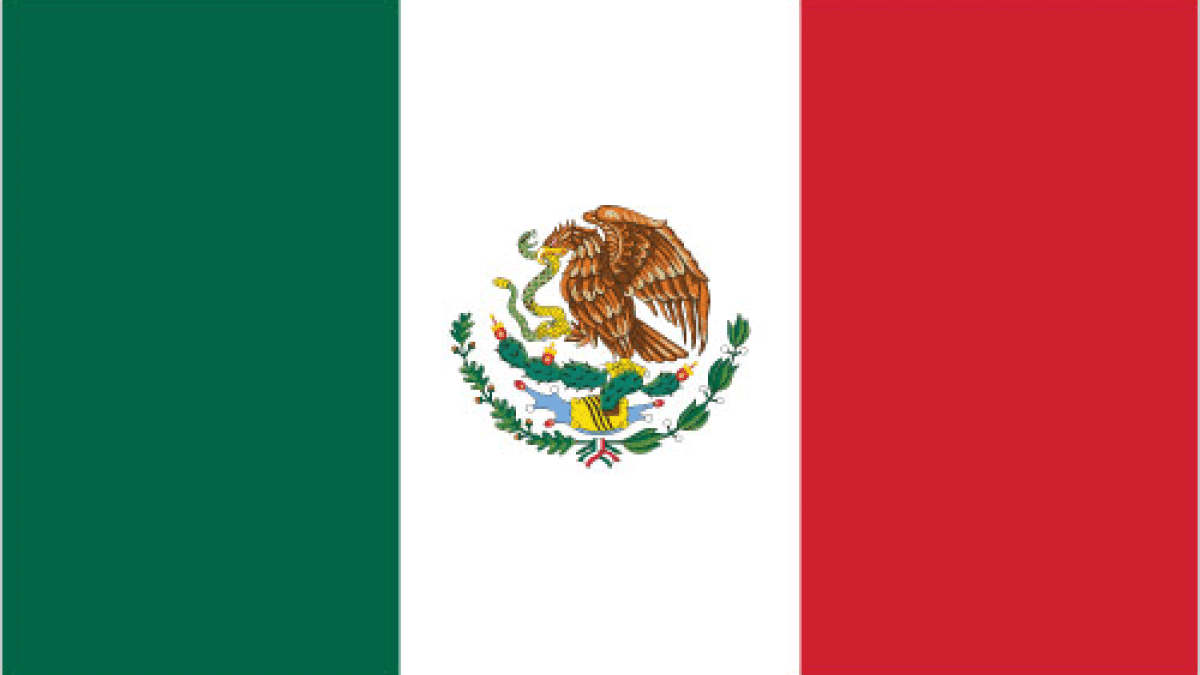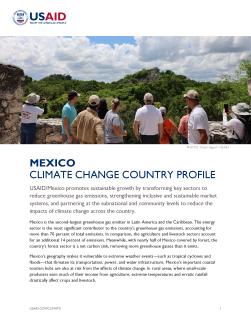FACT SHEET – USAID/Mexico promotes sustainable growth by transforming key sectors to reduce greenhouse gas emissions, strengthening inclusive and sustainable market systems, and partnering at the subnational and community levels to reduce the impacts of climate change across the country.
Mexico is the second-largest greenhouse gas emitter in Latin America and the Caribbean. The energy sector is the most significant contributor to the country’s greenhouse gas emissions, accounting for more than 70 percent of total emissions. In comparison, the agriculture and livestock sectors account for an additional 14 percent of emissions. Meanwhile, with nearly half of Mexico covered by forest, the country’s forest sector is a net carbon sink, removing more greenhouse gasses than it emits.
Mexico’s geography makes it vulnerable to extreme weather events—such as tropical cyclones and floods—that threaten its transportation, power, and water infrastructure. Mexico’s important coastal tourism hubs are also at risk from the effects of climate change. In rural areas, where small-scale producers earn much of their income from agriculture, extreme temperatures and erratic rainfall drastically affect crops and livestock.
Government of Mexico Climate Priorities
In December 2022, the Government of Mexico submitted an updated Nationally Determined Contribution (NDC) to the Paris Agreement. Key goals under Mexico’s current NDC include:
- Reducing greenhouse gas emissions by 35 percent and lowering black carbon emissions by 51 percent by 2030;
- Reaching a net-zero deforestation rate by 2030;
- Promoting sustainable and resilient food production systems; and
- Conserving and restoring biodiversity and ecosystem services.
USAID’s Climate Change Program: Objectives and Results
USAID promotes climate-sustainable growth by transforming key sectors to reduce greenhouse gas emissions. In alignment with USAID’s Climate Strategy 2022-2030, USAID/Mexico pursues these goals by advancing climate-friendly energy actions and policies that enable and scale energy efficiency, strengthen climate-friendly transportation and building standards, reduce methane emissions, and help mobilize climate finance initiatives. USAID/Mexico also implements nature-based climate solutions that address land-use change and environmental degradation, strengthen inclusive productive markets, and increase the value of sustainable natural resource management and environmental services.
By strengthening stakeholder coordination and advancing inclusive approaches to improve environmental governance, USAID is harnessing the transformative power of partnerships to achieve a climate-resilient future. Coordinating closely with the Government of Mexico, particularly at the subnational level, USAID helps pursue the country’s climate priorities through a series of programs and partnerships that promote energy efficiency and natural climate solutions.
Key Results
USAID has helped:
- Implement natural climate solutions programs that reduced emissions by an estimated 1.6 million tons of CO2 equivalent in FY 2023—the equivalent of taking approximately 340,000 passenger cars off the road for a year
- Leverage more than $18 million in private sector investment to reduce greenhouse gas emissions in Mexico in FY 2023
- Place more than 300,000 hectares of land under improved management in priority areas such as the Selva Maya—North America’s largest forest
- Support environmental programs—including Sustainable Landscape Ventures, Sustainable Prosperous Communities, and Southern Mexico Generating Employment and Sustainability —which aim to unlock more than $300 million of additional mobilized funds for natural climate solutions in priority landscapes
- Support the Net Zero Cities program, which seeks to mobilize $2.5 billion for energy efficiency projects and reduce greenhouse gas emissions equivalent to more than 4.1 million gasoline-powered passenger vehicles driven for one year
Key Programs
Partnership for Net Zero Cities (2022-2027)
This partnership seeks to place Mexico on a path to net-zero emissions after 2030 by increasing the energy efficiency of buildings and improving access to clean transportation. Expected results in target cities include energy efficiency savings of 1.7 million megawatt-hours, equivalent to the annual output of 3.3 natural gas-fired power plants; a 15 percent reduction in short-lived climate pollutants; and greenhouse gas emissions reduced or avoided to a level equivalent to more than 4.1 million gasoline-powered passenger vehicles driven for one year. Partner cities and states include Hermosillo, Sonora; Monterrey, Nuevo León; Guadalajara, Jalisco; Mérida, Yucatán; and Mexico City.
Southern Mexico – Generating Employment and Sustainability (SURGES) (2022-2027)
This project aims to mobilize investment and sales to support sustainable economic growth in southern Mexico. To achieve this goal, the project will connect buyers with smallholder farmers committed to sustainable environmental practices, with the objective of reducing emissions from land-use change and increasing income generation in key value chains, such as coffee, cacao, honey, and ecotourism. The project will also work with financial institutions to develop or strengthen financial products tailored to the needs of producer organizations and small- and medium-sized enterprises.
Sustainable Prosperous Communities (2021-2026)
This project seeks to increase the number of hectares of land under sustainable and profitable productive systems with access to markets, contributing to reducing deforestation and lowering greenhouse gas emissions while improving the livelihoods of smallholder producers. In addition, with a focus on southern Mexico and the Yucatan peninsula, the project aims to develop financial products tailored to smallholder producers’ needs and increase their capacity to access finance to drive sustainability, innovation, and scale to reach markets.
Sustainable Landscapes Ventures (2020-2025)
This project develops sustainable and inclusive value chains at scale that are market-driven and investor-ready in target landscapes. Through the promotion of low-cost financial services and a pipeline of investable projects, the project addresses financial barriers and catalyzes commercial investments in sustainable supply chains that preserve forests and improve livelihoods.
Co2munitario (2019-2024)
By applying the Climate Action Reserve’s Mexico forest carbon protocol1, this project will certify 202,000 hectares of forest in different states, including Aguascalientes, Oaxaca, State of Mexico, the Yucatan Peninsula, and Veracruz. The project prioritizes three components: 1) generation of carbon credits; 2) public policy and market strengthening; and 3) organizational capacity strengthening.
Sustainable Landscapes and Forest Transparency Activity Phase 2 (2023-2028)
In partnership with the U.S. Forest Service (USFS), USAID will strengthen Mexico’s forest and natural resource management practices at the national, subnational, and community levels. Through this activity, USAID will contribute to reducing emissions from land-use change and increasing the participation of women, youth, and other underrepresented populations in the forest sector. Building on past work, USFS is advancing the implementation of Mexico’s upgraded forest and information management systems at the national level to improve accessibility, transparency, and the legal commercialization of timber and non-timber forest products. At the sub-national level, USFS is also providing technical assistance to government institutions and local communities to strengthen their capacity to mitigate wildfires and manage timber and non-timber forest products.
1The Mexico Forest Protocol provides standardized guidance for carbon enhancement projects and addresses eligibility, baseline, inventory, permanence, social and environmental safeguards, and measurement, reporting and verification requirements
For More Information




